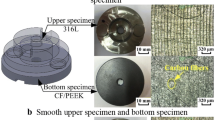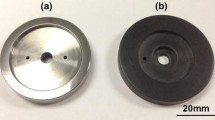Abstract
Bionic non-smooth surface is widely applied in metal and ceramics materials. In order to introduce this technology to high pressure seawater pump, the influence of bionic non-smooth surface on the engineering plastics used in pump should be investigated. The comparative tests are carried out with a ring-on-disc configuration under 800, 1000, 1200 and 1400 r/min in order to research the influence of the bionic non-smooth surface on glass fiber-epoxy resin composite(GF/EPR) under natural seawater lubrication. The disc surfaces are textured with five kinds of pits, which are semi-spherical, conical, cone-cylinder combined, cylindrical pits and through holes, respectively. A smooth surface is tested as reference. The results show that the lubrication performance of dimpled GF/EPR sample is much better than that of the smooth sample under all rotational speeds. The semi-spherical pits surface has more obvious friction reduction than the others, which shows that the least reduction is approximately 43.29% of smooth surface under 1200 r/min. However, the wear level is only marginally influenced by dimples. The surface morphology investigations disclose severe modifications caused by abrasive wear primarily. The results are helpful to vary friction properties of GF/EPR by non-smooth surface, or provide references to the design of non-smooth surfaces under certain condition.
Similar content being viewed by others
References
LIM G H, CHUA P S K, HE Y B. Modern water hydraulics-the new energy-transmission technology in fluid power[J]. Applied Energy, 2003, 76(1–3): 239–246.
JENG Yeau-ren, SHYU Shiuh-hwa. Influences of valve lifter foot surface treatment, surface texture and rotation on wear[J]. Wear, 2002, 252(11–12): 1016–1019.
HICKS D C, FEAM W A, PLEASS C M, et al. Development, testing and the economics of a composite/plastic seawater reverse osmosis pump[J]. Desalination, 1989, 73: 95–109.
ETSION Izhak. State of art in laser surface texturing[J]. Journal of Tribology, 2005, 127(1): 248–253.
GROPPER D, WANG L, HARVEY T J. Hydrodynamic lubrication of textured surface: A review of modeling techniques and key findings[J]. Tribology International, 2016, 94: 509–529.
ZHOU H, CHEN L, WANG W, et al. Abrasive particle wear behavior of 3Cr2W8V steel processed to bionic non-smooth surface by laser[J]. Material Science and Engineering A, 2005, 412(1–2): 323–327.
CHEN L, ZHOU H, ZHAO Y, et al. Abrasive particle wear behaviors of several die steels with non-smooth surfaces[J]. Journal of Material Process Technology, 2007, 190(1–3): 211–216.
CHEN L, REN L Q, ZHAO Y, et al. The wear-resistance of 3Cr2W8V steel with cave pit non-smooth surface processed by laser[J]. Journal of Bionic Engineering, 2008, 5: 34–39.
LUO K Y, WANG C Y, LI Y M, et al. Effects of laser shock peening and groove spacing on the wear behavior of non-smooth surface fabricated by laser surface texturing[J]. Apply Surface Science, 2014, 313: 600–606.
WANG X L, KATO K, ADACHI K, et al. The effect of laser texturing of SiC surface on the critical load for the transition of water lubrication mode from hydrodynamic to mixed[J]. Tribology International, 2001, 34(10): 703–711.
WANG X L, KATO K, ADACHI K, et al. Loads carrying capacity map for the surface texture design of SiC thrust bearing sliding in water[J]. Tribology International, 2003, 36(3): 189–197.
WANG X L, ADACHI K, OTSUKA K, et al. Optimization of the surface texture for silicon carbide sliding in water[J]. Apply Surface Science, 2006, 253(3): 1282–1286.
YUAN S H, HUANG W, WANG X L. Orientation effects of micro-grooves on sliding surfaces[J]. Tribology International, 2011, 44(9): 1047–1054.
YU H W, HUANG W, WANG X L. Dimple patterns design for different circumstances[J]. Lubrication Science, 2013, 25(2): 67–78.
WANG J Q, WANG X L. State of the art in innovative design of surface texture[J]. Journal of Mechanical Engineering, 2015, 51(23): 84–95. (in Chinese)
YAMAKIRI H, SASAKI S, KURITA T, et al. Effects of laser surface texturing on friction behavior of silicon nitride under lubrication with water[J]. Tribology International, 2011, 44(5): 579–584.
KOVALCHENKO A, AJAYI O, ERDEMIR A, et al. Friction and wear behavior of laser textured surface under lubricated initial point contact[J]. Wear, 2011, 271(9–10): 1719–1725.
HAO L C, MENG Y G, CHEN C. Experimental investigation on effects of surface texturing on lubrication of initial line contacts[J]. Lubrication Science, 2014, 26(5): 363–373.
WAKUDA M, YAMAUCHI Y, KANZAKI S, et al. Effect of surface texturing on friction reduction between ceramic and steel materials under lubricated sliding contact[J]. Wear, 2003, 254(3–4): 356–363.
ULRIKA P, STAFFAN J. Textured surfaces for improved lubrication at high pressure and low sliding speed of roller/piston in hydraulic motors[J]. Tribology International, 2007, 40(2): 355–359.
TONG R T, LIU G, LIU T X. Friction characteristics of nanoscale sliding contacts between multi-asperity tips and textured surfaces[J]. Chinese Journal of Mechanical Engineering, 2013, 26(6): 1109–1117.
TONG R T, LIU G, LIU T X. Two dimensional nanoscale reciprocating sliding contacts of textured surfaces[J]. Chinese Journal of Mechanical Engineering, 2016, 29(3): 531–538.
YIN B F, LI XD, F U YH, et al. Effect of laser textured dimples on the lubrication performance of cylinder in diesel engine[J]. Lubrication Science, 2012, 24(7): 293–312.
WU S F, GAO D R, LIANG Y N, et al. Influence of non-smooth surface on tribological properties of glass fiber-epoxy resin composite sliding against stainless steel under natural seawater lubrication[J]. Chinese Journal of Mechanical Engineering, 2015, 28(6): 1171–1176.
LIANG Y N, GAO D R, WU S F. Hydrodynamic lubrication calculation for slipper/swash plate pair with bionic non-smooth concave surface[J]. Journal of Mechanical Engineering, 2015, 51(24): 153–160. (in Chinese)
PIHTILI H. An experimental investigation of wear of glass fibre-epoxy resin and glass fibre-polyester resin composite materials[J]. European Polymer Journal, 2009, 45(1): 149–154.
MENEZES P L, KISHORE, KAILAS S V, et al. Tribological response of soft materials sliding against hard surface textures at various numbers of cycles[J]. Lubrication Science, 2013, 25(2): 79–99.
HU T C, HU L T. The study of tribological properties of laser-textured surface of 2024 aluminium alloy under boundary lubrication[J]. Lubrication Science, 2012, 24(2): 84–93.
WANG Z Q, GAO D R. Comparative investigation on the tribological behavior of reinforced plastic composite under natural seawater lubrication[J]. Material & Design, 2013, 51: 983–988.
WANG Z Q, GAO D R. Friction and wear properties of stainless steel sliding against polyetheretherketone and carbon-fiberreinforced polyetheretherketone under nattral seawater lubrication[J]. Material & Design, 2014, 53: 881–887.
Author information
Authors and Affiliations
Corresponding author
Additional information
Supported by National Natural Science Foundation of China(Grant No. 51375421), and Key Project of Science and Technology Research of Hebei Province, China (ZD20131027)
WU Shaofeng, born in 1987, is currently a PhD candidate at School of Mechanical Engineering, Yanshan University, China. His research interests include lubrication mechanism and friction and wear of the high pressure seawater axial piston pump.
GAO Dianrong, born in 1962, is currently a professor at School of Mechanical Engineering, Yanshan University, China. He received his bachelor PhD degree from Yanshan University, China, in 2001. His research interests include CFD, PIV and new types of fluid components and devices.
LIANG Yingna, born in 1982, is currently a PhD candidate at School of Mechanical Engineering, Yanshan University, China. She received her bachelor degree in 2004, master degree in 2008 from Yanshan University, China. Her research interests include lubrication mechanism and friction and wear of the high pressure seawater axial piston pump.
CHEN Bo, born in 1990, is currently a PhD candidate at School of Mechanical Engineering, Yanshan University, China. His research interests include lubrication mechanism and friction and wear of the high pressure seawater axial piston pump.
Rights and permissions
About this article
Cite this article
Wu, S., Gao, D., Liang, Y. et al. Experimental study on influence of dimples on lubrication performance of glass fiber-epoxy resin composite under natural seawater lubrication. Chin. J. Mech. Eng. 30, 110–117 (2017). https://doi.org/10.3901/CJME.2016.0620.075
Received:
Revised:
Accepted:
Published:
Issue Date:
DOI: https://doi.org/10.3901/CJME.2016.0620.075




